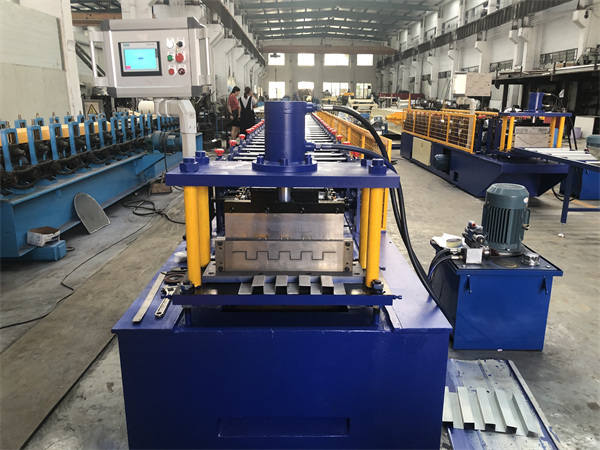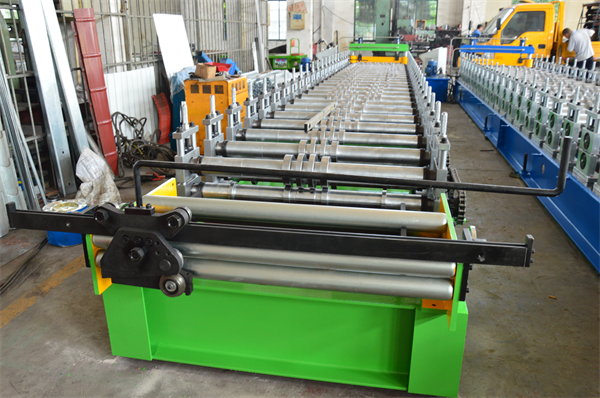1. परिचय
In the ever-evolving world of manufacturing, efficiency and precision are paramount. The double stage roll forming machine has emerged as a game-changer in the production of metal profiles for various industries. This article explores the workings, advantages, applications, components, and maintenance of double stage roll forming machines, shedding light on their significance in modern manufacturing processes.
2. What is a Double Stage Roll Forming Machine?
A double stage roll forming machine is an advanced piece of equipment used to convert flat metal coils into custom-designed profiles with consistent cross-sections. It operates in a continuous process, ensuring a high level of efficiency and accuracy in metal forming. The double stage system refers to the presence of two sets of roll forming stations, enabling the production of more complex profiles in a single pass.
3. How Does a Double Stage Roll Forming Machine Work?
The operation of a double stage roll forming machine involves multiple stages. Initially, a coil of metal is loaded onto the uncoiler, and the coil car feeds the metal to the machine. The material then passes through the first set of roll forming stations, where it gradually takes the desired shape. After the first stage, the partially formed profile enters the second set of roll forming stations, undergoing further shaping and refinement. Finally, the cut-off system trims the profile to the desired length.

4. Advantages of Double Stage Roll Forming Machines
4.1 Increased Production Efficiency
One of the primary benefits of using a double stage roll forming machine is its ability to streamline the manufacturing process. By combining two stages into one continuous operation, the machine significantly reduces production time, leading to higher output rates.
4.2 Versatility in Forming Different Profiles
Double stage roll forming machines offer exceptional flexibility in creating various metal profiles. With multiple roll forming stations, manufacturers can easily produce diverse shapes and sizes without the need for extensive adjustments.
4.3 Enhanced Precision and Consistency
The precise and repetitive nature of roll forming ensures uniformity in the final product. The double stage process further improves accuracy, resulting in consistent and high-quality metal profiles.
4.4 Cost-effectiveness
Despite their sophisticated design, double stage roll forming machines are cost-effective in the long run. The efficiency and reduced scrap rates contribute to overall cost savings for manufacturers.
4.5 Space-saving Design
As a single machine combining multiple stages, a double stage roll forming machine occupies less floor space compared to traditional manufacturing setups, optimizing the use of the factory area.
5. Applications of Double Stage Roll Forming Machines
Double stage roll forming machines find applications across various industries due to their versatility and efficiency. Some common applications include:
- Roofing and Cladding Profiles
- Building and Construction Components
- Automotive Parts
- Storage Systems and Shelving
- Door and Window Frames
- Electrical Enclosures

6. Key Components of a Double Stage Roll Forming Machine
6.1 Uncoiler and Coil Car
The uncoiler serves as the starting point of the roll forming process. It holds the metal coil and gradually feeds it into the machine. The coil car facilitates easy loading and positioning of heavy metal coils onto the uncoiler, ensuring a smooth material supply to the forming stations.
6.2 Feeding System
The feeding system consists of rollers and guides that guide the metal coil through the machine. It ensures a consistent and precise feeding of the material into the roll forming stations, minimizing material wastage and ensuring accurate profile formation.
6.3 Roll Forming Stations
The heart of the double stage roll forming machine lies in its roll forming stations. These stations consist of a series of rollers, each carefully shaped to bend the metal progressively into the desired profile. The number and configuration of these stations depend on the complexity of the profile being formed.
6.4 Cutting System
Once the metal has passed through all the roll forming stations, the cutting system comes into action. It cuts the continuous profile into individual pieces of the desired length. Various cutting mechanisms, such as flying shears or hydraulic cutters, are employed based on the requirements of the manufacturing process.
6.5 Control System
The control system is the brain of the double stage roll forming machine. It ensures smooth coordination between various components and processes. Advanced control systems utilize programmable logic controllers (PLCs) and human-machine interfaces (HMIs) to enable easy operation, real-time monitoring, and troubleshooting.
7. Types of Profiles Formed by Double Stage Roll Forming Machines
7.1 C and Z Profiles
Double stage roll forming machines are commonly used to create C and Z profiles. These profiles are widely utilized in construction for roof purlins and wall girts. Their design provides structural stability and efficient load-bearing capabilities.
7.2 Roofing Panels
Roofing panels are a popular application of double stage roll forming machines in the construction industry. These panels are widely used in commercial and residential buildings due to their durability, weather resistance, and aesthetic appeal.
7.3 Door Frames and Jambs
Double stage roll forming machines are ideal for producing door frames and jambs. These components require precise dimensions and high strength to ensure proper door assembly and functionality.
7.4 Shelves and Racks
The versatility of double stage roll forming machines extends to manufacturing storage solutions such as shelves and racks. These components are essential in warehouses, retail stores, and industrial facilities for organizing and storing goods efficiently.
8. Factors to Consider When Choosing a Double Stage Roll Forming Machine
8.1 Material Compatibility
When selecting a double stage roll forming machine, it is crucial to consider the types of materials it can handle. The machine should be compatible with a range of metal coils, including steel, aluminum, and stainless steel, to meet different manufacturing requirements.
8.2 Speed and Production Capacity
Production speed is a critical factor in manufacturing operations. The chosen machine should have an appropriate production capacity that aligns with the desired output and customer demand.
8.3 Customization Options
Every manufacturing process may require specific profile dimensions. Opting for a machine that allows easy adjustment and customization of roll forming stations can significantly enhance production flexibility.
8.4 Maintenance and Support
Regular maintenance is vital for the smooth functioning and longevity of the machine. Choosing a supplier that offers comprehensive maintenance support and readily available spare parts is essential for uninterrupted operations.

9. Safety Measures for Operating a Double Stage Roll Forming Machine
9.1 Employee Training and Education
Proper training and education are essential for the safe operation of the machine. All personnel involved in using the double stage roll forming machine should be adequately trained in its operation, safety protocols, and emergency procedures.
9.2 Machine Guarding
Appropriate machine guarding is critical to prevent accidents and protect operators from moving parts during the manufacturing process.
9.3 Regular Maintenance and Inspection
Regular maintenance and inspection routines are essential to identify and address any potential safety hazards or mechanical issues promptly.
10. Common Challenges and Troubleshooting Tips
10.1 Material Jamming
Material jamming can occur if the metal coil is not guided smoothly through the feeding system. Regular inspection and maintenance of the feeding components can prevent this issue.
10.2 Misaligned Rollers
Misaligned rollers can lead to irregular profile shapes and dimensions. Ensuring that the roll forming stations are properly aligned and adjusted can help avoid this problem.
10.3 Inconsistent Product Dimensions
Inconsistent product dimensions may arise due to worn-out or damaged rollers. Regular replacement and maintenance of these components can rectify the issue.
10.4 Electrical Malfunctions
Electrical malfunctions can disrupt the operation of the machine. Regular inspection of the control system and electrical components can prevent potential breakdowns.
11. Maintenance Tips for a Double Stage Roll Forming Machine
11.1 Lubrication
Proper lubrication of moving parts is essential to reduce friction and wear. Regularly lubricating the rollers, cutting systems, and other moving components will extend their lifespan.
11.2 Cleaning and Debris Removal
Regularly cleaning the machine and removing debris ensures smooth operation and reduces the risk of material jamming.
11.3 Regular Inspection
Frequent inspection of all components helps identify wear and tear, allowing timely replacement and preventing costly breakdowns.
12. Innovations in Double Stage Roll Forming Technology
Continuous advancements in roll forming technology have led to various innovations in double stage roll forming machines. Some notable developments include:
- Integration of 3D modeling and simulation for profile design optimization
- Introduction of automated roll forming stations for enhanced precision
- Implementation of servo-driven systems for improved control and energy efficiency
13. Environmental Impact and Sustainability
Double stage roll forming machines contribute to sustainability in manufacturing through several factors:
- Reduced material wastage due to precise forming processes
- Energy-efficient design and operation
- Longer product lifespans and durability, reducing replacement frequency

14. निष्कर्ष
Double stage roll forming machines have transformed the manufacturing industry by providing efficient, precise, and versatile solutions for metal profile production. Their ability to streamline processes, enhance product consistency, and accommodate various applications makes them indispensable tools for modern manufacturers.
Incorporating safety measures, regular maintenance, and staying updated with technological advancements will ensure that double stage roll forming machines continue to revolutionize metal forming processes for years to come.
पूछे जाने वाले प्रश्न
- Q: What materials can a double stage roll forming machine work with?
- A: Double stage roll forming machines can work with various metal coils, including steel, aluminum, and stainless steel.
- Q: What are the primary advantages of using a double stage roll forming machine?
- A: Some advantages include increased production efficiency, versatility in forming different profiles, enhanced precision and consistency, cost-effectiveness, and a space-saving design.
- Q: What applications are suitable for double stage roll forming machines?
- A: Double stage roll forming machines find applications in roofing and cladding profiles, building components, automotive parts, storage systems, door frames, and more.
- Q: How can I ensure the safety of operators while using a double stage roll forming machine?
- A: Ensure proper employee training, implement machine guarding, and conduct regular maintenance and inspections to ensure safe operation of the double stage roll forming machine.
- Q: What are some common challenges that may arise during the operation of a double stage roll forming machine?
